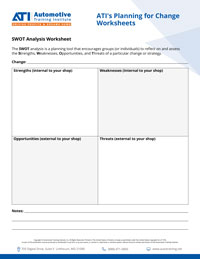How to prepare your shop for change
Change is constant in business. To be successful in today’s market, you must be willing to try to understand it and embrace it. Whether voluntary or involuntary, it can affect every aspect of your shop, including your employees, customers, and even sales. For many, it can bring about feelings of fear and uncertainty. That is why it is important to be proactive and prepare for issues that can arise when making changes or adapting to changes affecting your business.
Types of changes and responses
Change can be initiated in two ways: external and internal influences.
External influences such as laws, regulations, and advancements in technology are out of one’s control and are in many ways easier to accept and deal with for that reason. Many savvy business owners proactively watch trends to figure out how to adapt and gradually work toward implementing or modifying their shop’s affected processes, resources, or structures. This is necessary for survival. The shops that can’t adapt will be at risk of going out of business.
Internal influences are changes within the shop, most likely due to factors relating to employees, customers, finances, or other business concerns that may affect production, profitability, and operations. With internal influences, leaders can control and prepare for the changes they want to make and lead the implementation process more effectively. Successfully implementing these changes involves training, communication, and to some degree, the buy-in of those affected by the changes.
The shop owner is responsible for guiding their team through adopting the change. As the leader, you must keep in mind that each employee will respond to change differently. Be prepared for any response. Below are the most common responses to change:
1. Denial: Employees feel that the change is unnecessary or irrelevant and will deny the facts presented and withhold support.
2. Fear: Some employees resist change because they fear the unknown, not knowing how it will affect their job or comfort zone.
3. Anger: Some employees get angry when their predictable constancy is disrupted, which leads to lashing out, being uncooperative, and maybe even acts of sabotage.
4. Indifference: Some employees may not care about the change, especially if it has nothing to do with their role. The risk is that they may not know all the ins and outs of the change, be willing to participate in the process until they know the big picture — the benefits to the business, the employees, and the customers.
5. Acceptance: Employees see a change as an improvement. They understand that the change may take time and are willing to do their part in the process.
Building a plan for change
To address each response type, shop owners should hold weekly one-on-one and team meetings to alleviate employee fears, hear and address their feedback, and make them feel more comfortable with upcoming changes. During this time, you should ask open-ended questions, encourage dialog, and listen deeply. Then, use the information gathered to build an action plan that gains buy-in by removing obstacles.
Your plan of action must address the following key questions:
- What information should you present to build a case for a change?
- What will persuade employees to change negative perceptions?
- What will be the course of action for addressing employees that refuse to change?
- Who are the key employees involved in implementing the change?
Dealing with negative reactions
Not all employees will agree on the change you are trying to implement. Remember, in general, people do not like change. With any change you propose, you’re likely to encounter some resistance and pushback from employees.
When employees are resistant, ask for their feedback on the changes you are planning and consider the options they present. Employees will feel more involved and in control knowing that they had some input on implementing the change. It is also likely that their negative attitudes will become positive, and they’ll eventually become a change advocate.
Another way to change negative attitudes is to be transparent. Share the facts and reasons behind the decision to make the change, including how it will benefit employees and their work environment. Increasing awareness of a change’s purpose and benefits helps you garner support. You can also perform a Force Field Analysis — a technique used to determine and analyze the forces for and against a change.
A good way to apply this technique in your shop is first to host a meeting to announce the need for the change and discuss the following details as a team:
- State why the change is needed.
- List the pros of making the change versus the cons of not making the change.
- Allow others to take leadership roles; appropriately delegating will garner much support.
- Align the benefits of the change to your business goals and employees’ personal goals.
- Allow time for Q&A anytime they request information and feedback.
The results of these meetings should give you the feedback you need to gain buy-in and address any potential roadblocks to a successful implementation process.
Remember, as the leader and shop owner, you are ultimately responsible for making sure that the implementation of your shop’s changes runs smoothly. To do this, you must provide guidance, encouragement, and supervision throughout the process.
Making change happen is hard for any leader. However, it is a process that can be mastered and yield remarkable results for your customers, employees, and your business. Change is a necessary part of continual development, which places your shop in a better position in your marketplace.
To put the above tips into action and ensure that all your shop’s changes go as planned, get ATI’s Planning for Change Worksheets. This bundle features helpful guides and worksheets designed to organize your thoughts, gain feedback and buy-in from your team, and plan your shop’s course of action. To receive your copy of the bundle, go to www.ationlinetraining.com/2021-07 for a limited time.




